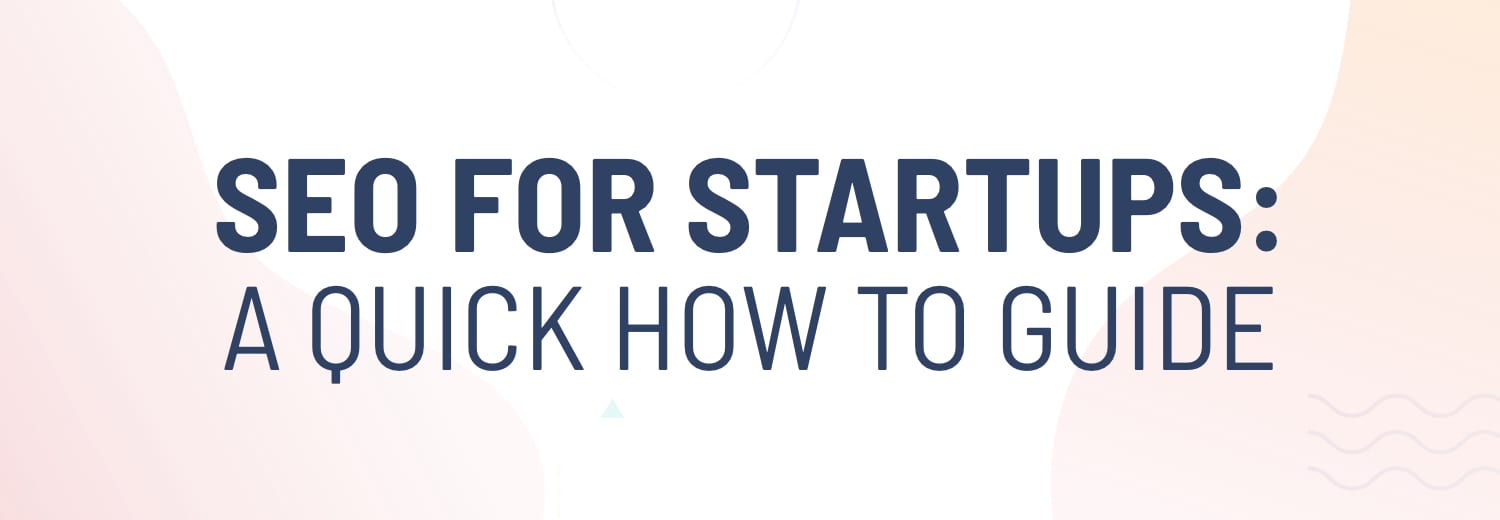SEO for startups is really no different to anyone else. You’re playing under the same rules and competing on the same platform (or platforms, if you include Bing and others).
However, you’re starting from zero, and depending on your industry, you could be up against some stiff competition. And as most people know, SEO is a long game, which can require years of investment.
So this can make startup SEO seem daunting, even downright impossible, to anyone that’s just starting out. But as with everything in life, the sooner you start the sooner you’ll see the benefits.
First, a bit of theory
Way to many startup SEO guides jump straight into talking about keyword research, how to earn backlinks, or technical considerations. Yes, these are all crucial elements, but you need to first conceptualise what SEO is and how to create a strategy that is based on your goals.
Therefore, the first thing I educate people on, be they startup founders or marketing interns, is search theory.
So I’ll start by defining what exactly is search?
Well if this were a job interview, I would answer it like this: Search aims to match the user intent of a search term with content that will best resolve that user intent.
Or in plain English, it’s Google’s aim to provide content that will answer what it is you’re searching for. And what it is you’re searching for is known as user intent (or search intent). And understanding the user intent of searches is crucial to developing a good understanding of SEO.
User Intent
A very useful way to think about user intent is with the following categories of search: Do – Know – Go
- Do (Transactional queries): A user wants to purchase a product or service, which can be completed either online or offline
- Know (Informational queries): A user wants to answer a question or learn more about a subject
- Go (Navigational queries): A user wants to visit a specific website via searching the brand name
PRO TIP: certain signifiers in a keyword search query tell us what the user intent is. Words like buy, shop, company, firm, agency, purchase, service, supplier etc, all suggest the user intent is transactional.
Whereas search terms containing words such as what, why, when, where and how suggest that the user intent is informational.
Although this isn’t a perfect system of categorization, as plenty of search terms have ambiguous user intent. For example, the user intent behind the term “PR for startups” could be a user looking for information on how to do PR for their startup, or a user looking for a PR agency for their startup.
Understanding user intent heavily influences which types of keyword searches you target and what content you create to capture these searches. For example, your homepage and product landing pages would be used to target transactional searches. Whereas blog posts and guide pages would be used to capture informational searches. The below infographic provides more details on this.
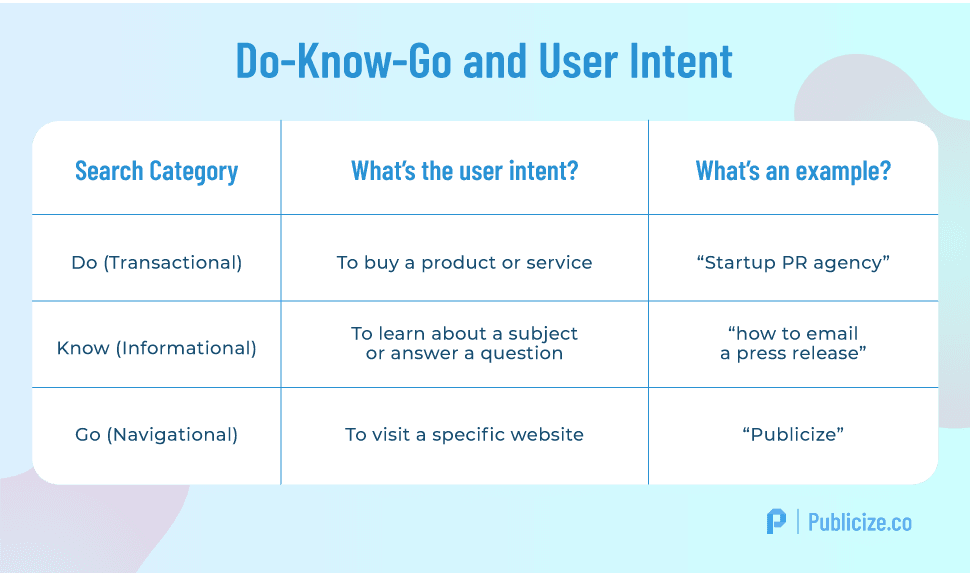
The Purchase Funnel
These search categories and the user intent that lay beneath them can then be applied to the purchase funnel, as the following infographic shows.
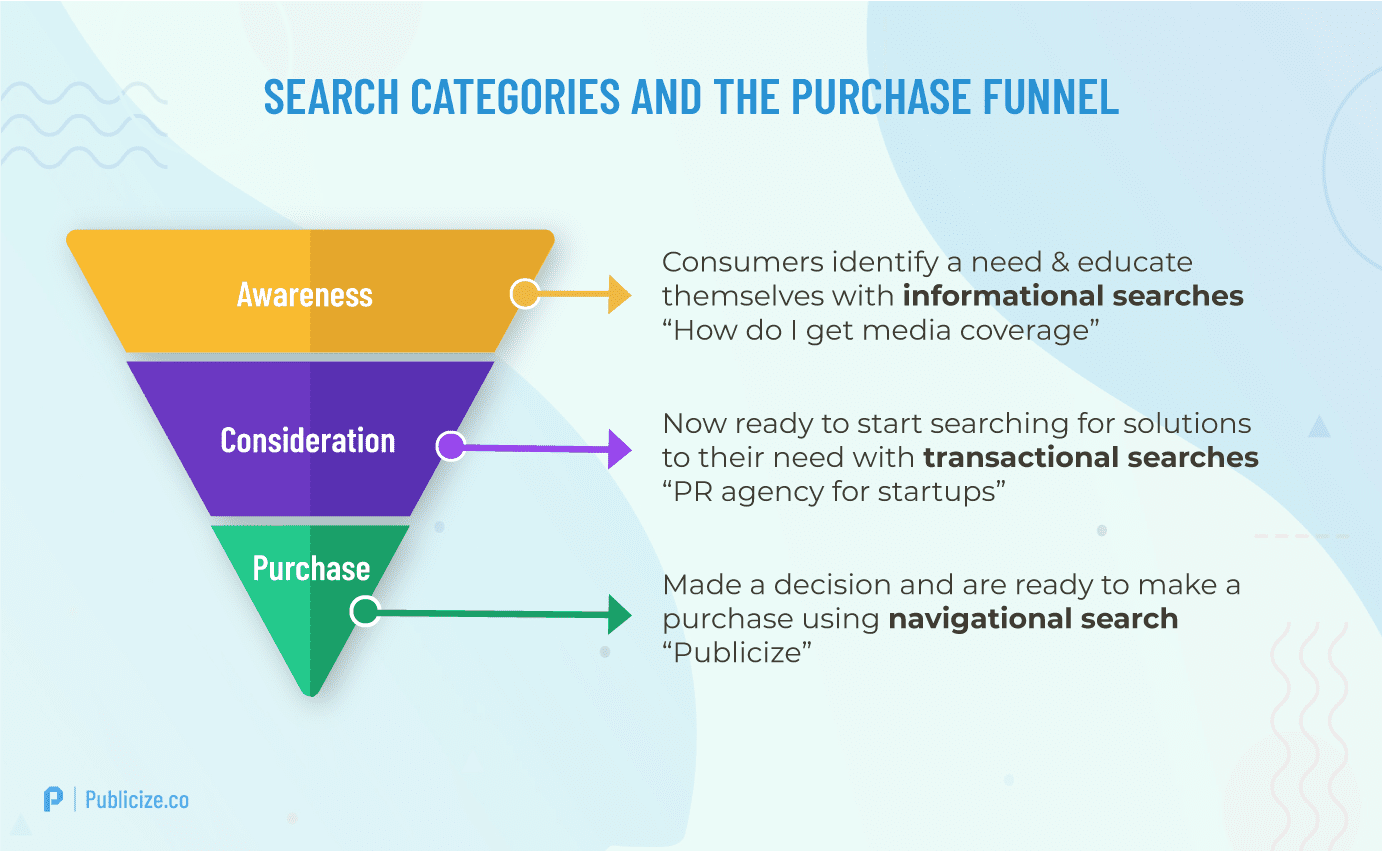
This tells us a number of important things when it comes to planning a startup SEO strategy:
- Targeting informational search can be an effective way of increasing organic traffic, building awareness of your brand and generating top of the funnel leads. However, this type of search traffic is less likely to convert into paying customers, as they’re not actively looking for your product.
- Focusing more on transactional search may lead to less website traffic compared to capturing informational search. But this traffic is further down the purchase funnel and are actively looking for your product or service. Therefore they’re more likely to end up converting into paying customers.
Most startup SEO strategies should focus on capturing both types of search, but where you focus the most attention will depend on your goals (which is discussed in the next section).
There are other factors you need to consider as well, which impact on this. Informational content can be much more effective than transactional content when it comes to link building (this is also discussed later in this guide). For example, a useful “how-to guide” or original piece of research is far more likely to pick up backlinks than a product landing page. Therefore, it’s not just your end goal you need to think about, but the other factors required to achieve it.
The Search Curve
Another way we categorize search is with the search curve. This has nothing to do with user intent. It instead splits search into query lengths, which shows us the search volume versus competitiveness of each category, as the following infographic shows.
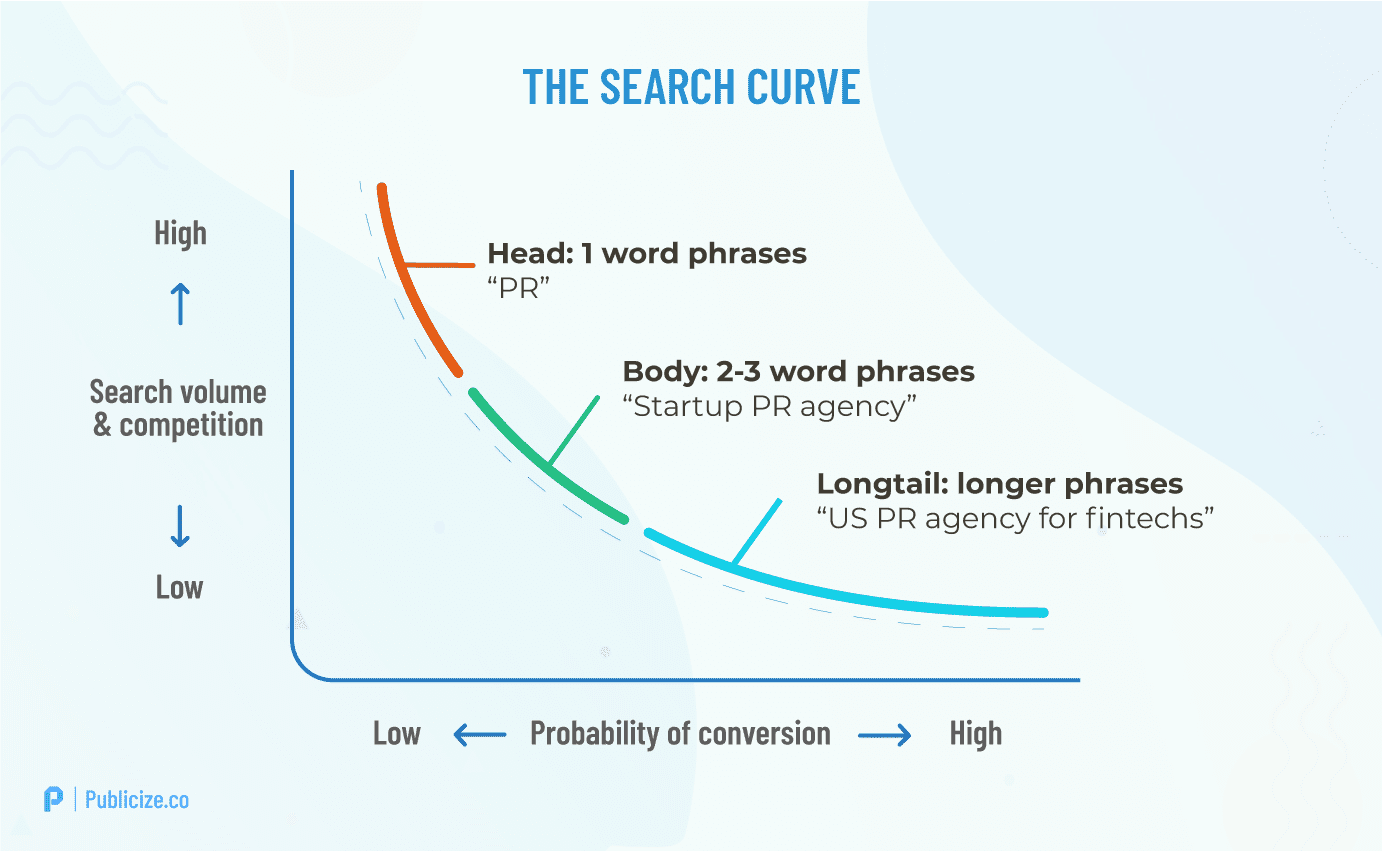
Once again, this tells us some really useful information when it comes to SEO for startups:
- Head terms: In most circumstances, you wouldn’t want to target these terms. This is because they’re super competitive and it’s usually impossible to understand the user intent. For example, someone searching for “PR” could be: looking for a definition of what PR is, searching for a PR agency, looking to learn how to do PR, or looking for PR news. If you search for this term, you’ll see that Google isn’t too sure either, and returns a range of different content.
- Body terms: These are often seen as the Goldilocks terms: the perfect combination of good volume and average competitiveness. The user intent is also much clearer, enabling you to consider what type of content you need to create to capture these terms.
- Long-tail terms: These are the easiest terms to rank for, but have the lowest search volume. Therefore, they act as the “foot in the door” for most startups, enabling you to start ranking for search terms and capture traffic.
Defining your goals
Now you understand the theory and the impact this has on an SEO strategy, you now need to start thinking about your goals. It’s important to think beyond just “getting more traffic”. This is a means to an end, not an end in itself.
So here are some common SEO goals:
- Build your brand awareness
- Reach new audiences
- Increase sales or leads
You then need to think about how you’ll measure success. So for each of the above examples, here’s how you could do that:
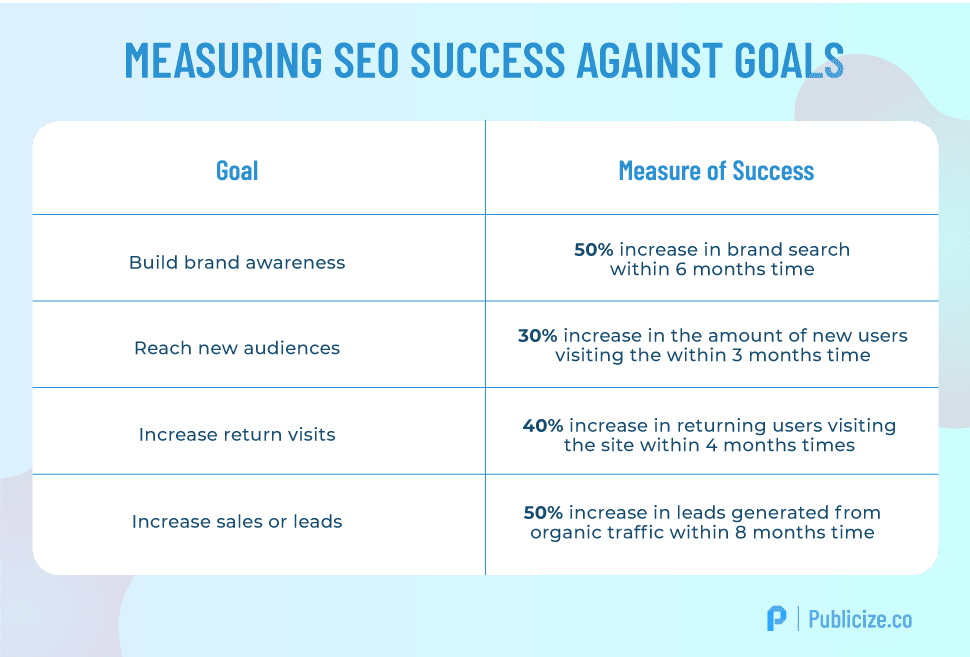
Once you’ve defined your goals you can then start planning how these will influence your startup SEO strategy. Referring back to the previous example again, here’s an explanation of the thought process with this:
- Build brand awareness: If you’re looking to build awareness among your target audience, then creating lots of informational content that addresses many of their pain points, wants and needs can help you to achieve this.
- Reach new audiences: You’ll want to reach both users looking for your service and users looking for information that’s related to this. So you’ll need to target a good mix of informational and transactional keywords.
- Increase sales or leads: You can target both informational and transactional searches. However, in order to convert a decent amount of informational searches you’ll need a top of the funnel lead capture process, such as gated content. This will allow you to nurture these into middle of the funnel leads. Whereas transactional searchers have clear commercial intent and are shopping around for your product or service, so should convert at a far higher rate, with less need for lead magnets.
Planning your content
This is what it all comes to. Yes, estimates put the range of Google ranking factors at anywhere between 200 to 400. But at the end of the day, the whole point of search is to connect users with relevant content. So everything else, from link building to technical SEO, is just how you ensure your content can be found by users.
Follow this process to uncover what content you should create for SEO.
Define your target audience
The first thing to do is to put yourself in your customers’ shoes. You need to understand their pain points, wants and needs. Once you know this, you can start thinking about the types of searches they make in Google. To do this, start with the following:
- Write down your ideal buyer persona. What are their interests, background, knowledge level and objectives?
- If you have an existing database of users/customers or a social media following, canvas this audience with surveys or questionnaires. Ask questions about their wants and needs, relevant to your product or service.
- If your website is already receiving some traffic, use the audience report in Google Analytics to uncover lifestyle data.
Once you’ve gathered some educated presumptions and data, think about the following:
- What are the pain points of your audience?
- Want common queries and needs do they have, which are related to your product or service?
- How would they search for your product or service?
- Would they search for specific elements or outputs of your product or service?
For example, here at Publicize, we’re a PR company aimed at startups. Our buyer persona is a founder or CEO, aged 25-40, highly educated, interested in tech culture, who wants to grow their business but is very time poor.
Their pain points include spending too much of their time trying to get exposure for their business, and not knowing how to go about winning media coverage.
Common queries and needs include how to contact journalists, how send a press release and how to find journalists’ contact details.
They search for our service using terms that literally describe what it is we do, or the service that we provide, such as “PR for startups” or “startup PR agency”.
Specific elements or outputs of our service that they may search for include things like startup press releases and white paper writing.
Competitor analysis
Now that you have some presumptions on the types of search terms your target audience is using when looking for your product or service, you can move onto competitor research.
- Make a list of who you consider to be your top 5 competitors.
- Now widen the net by searching Google for those terms you wrote down in the previous step that describe your product or service. Make a list of any competitor websites that appear in the first few positions, who aren’t already on your list.
Now you can start sleuthing on your competitors. This exercise is extremely important, as one of the first things you should ask when devising any marketing strategy is how are my most successful competitors being so successful. Well, with SEO, this is how you can find out.
I recommend you use SEMrush for this (while Moz would be my second choice). It’s an extremely versatile SEO and search marketing tool. While you need to pay a monthly subscription, the first month is free, and a month is plenty of time to do your research. So set yourself a reminder to cancel your subscription and it won’t cost you anything.
First step, enter your competitor’s domain into the below search bar (minus https://www.) then select organic research:
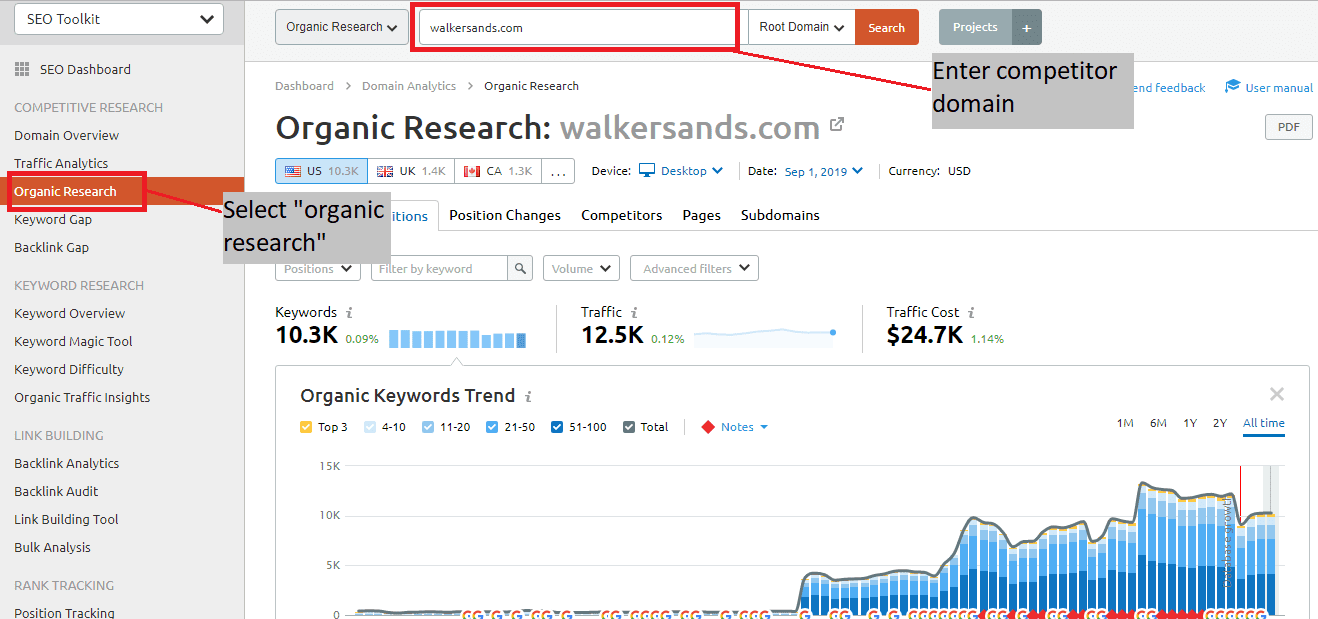
If you select the “positions” tab, then scroll down, you’ll see a complete list of every keyword the competitor is ranking in Google for, what position they’re ranking for and the page that is capturing this keyword:
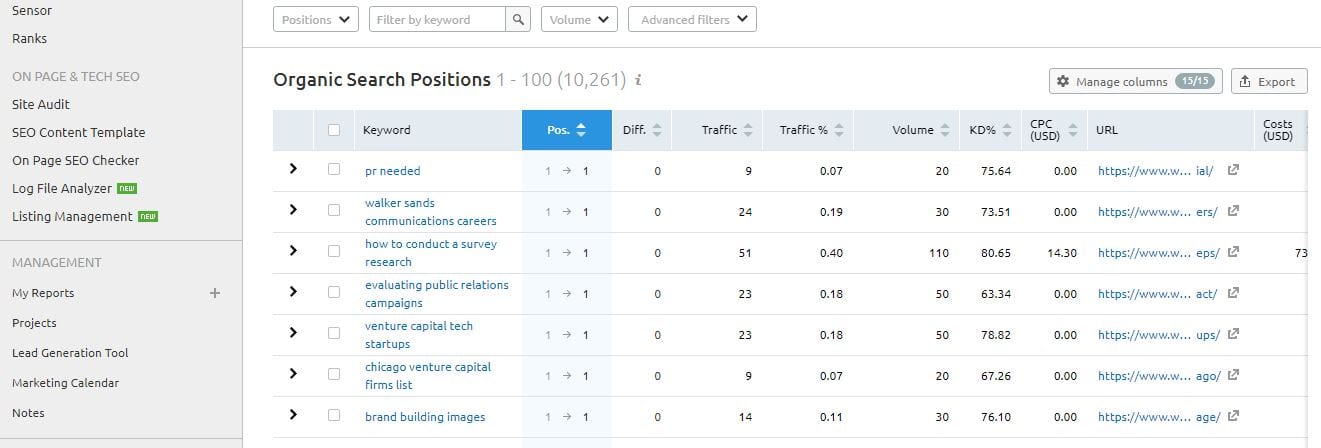
I find the easiest way to analyse this data is to download it into a spreadsheet, then go through the following process:
- Filter out any keywords that contain the company’s brand name. As per the above section, this is a navigational search and isn’t relevant to our research.
- Set the URL column filter so it only shows the homepage. This will usually be capturing a lot of body transactional keyword terms, copy and paste all of these keyword terms that are relevant to your product or service into a separate spreadsheet.
- Next, look for further transactional keyword terms being captured by other pages. These keywords will usually be more long tail and will often be captured by product or service landing pages. Look at the URL results, landing page URL will often be organised in URL subfolders such as competitor.com/services/page-name, as the below example shows:

- If you can spot these pages, set the URL filter to these and copy and paste all relevant keywords into your separate spreadsheet. Also – take a look at the pages capturing these keywords, so you have an idea of the type of content that captures these terms.
- Now you can start looking at what type of informational search terms your competitors are ranking for. Go back to the URL column filter and see if you can find an obvious sub folder structure where pages capturing these searches are located, this could be something like competitor.com/blog/page-name, as the below example show:

- You may end up with A LOT of results here. So you can apply further filters, such as a keyword difficulty score below 75 and a monthly search volume of more than 20. Copy and paste all search terms that you feel are relevant to your business into your other spreadsheet. Once again, it’s useful to look at some of these pages that are capturing these keywords, so you can start to get a sense of the type of content you will need to create.
Keyword Research
By now you’ll have your list of keyword presumptions you made in the competitor research step, plus a big list of transactional and informational keywords that your competitors are ranking for, along with monthly search volumes, difficulty scores and the URLs to the pages capturing these searches.
Now you need to expand on this with some keyword research.
- Go back into SEMrush, click on “Keyword Magic Tool”, then enter a transactional body keyword term from your previous research into the search bar.
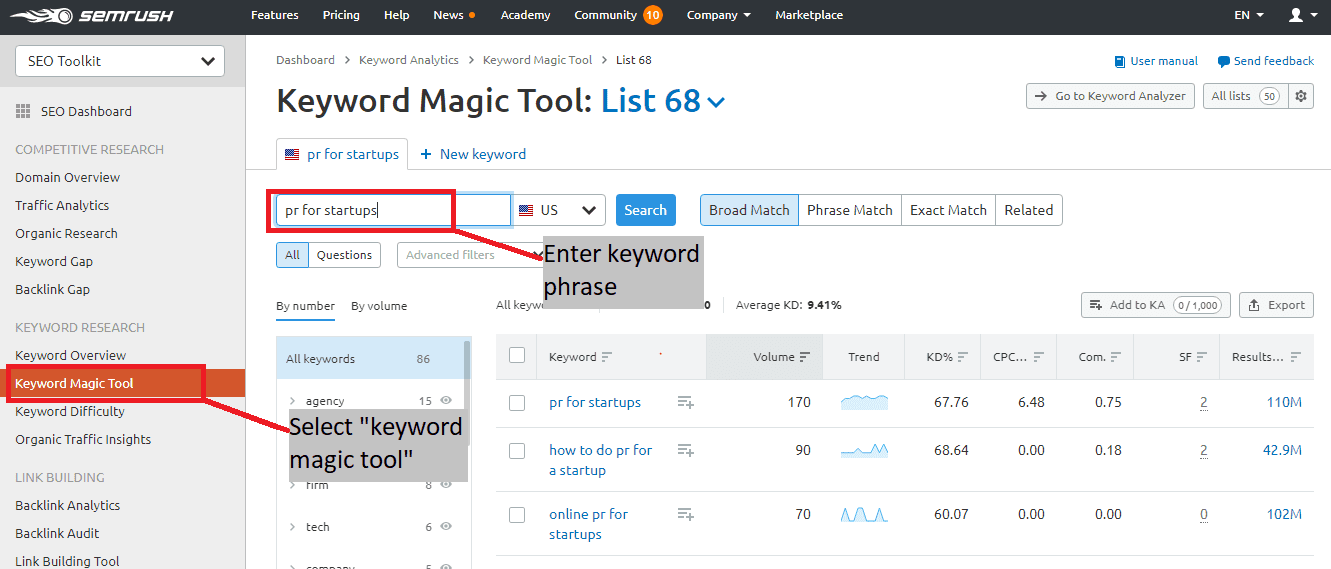
- You’ll now be able to view all broad matches, phrase matches, exact matches and related keywords. Select all keywords that you feel are relevant to your product and service, then click on “Add to KA” to add all of these to the Keyword Analyzer tool.
- Complete this process, exploring all body transactional terms, and adding all relevant keywords you uncover to the Keyword Analyzer tool.
- Now select a new list in the Keyword Magic Tool (from the drop down at the top of the page), and repeat the process for longtail transactional keywords.
- And finally, do the same for informational keywords.
You’ll now have different lists created for the following:
- Body transactional keywords. These are the keywords your homepage should be targeting.
- Longtail transactional keywords. These are the keywords you could try and capture with product or service landing pages
- Informational keywords. These are the keywords that will inform your blog output and any other informational content on your site.
Depending on the market that you’re in, you could have some pretty long lists, so you’ll need to refine. As a startup, it’s going to be difficult to rank for any competitor terms. Therefore you need to begin by targeting less competitive terms. You can filter keyword the keyword competitiveness to less than 65, which give you a better view of keywords that are more achievable to rank for.
With your final list, you’ll be able to start planning the type of content you’ll need to create for the keywords you’re aiming to capture. Here’s a hypothetical example of our content structure, aimed at capturing a broad mix of body and longtail transactional searches, and informational searches.
Creating content for SEO
Now it comes to writing content to capture your target keywords, approach this will two things in mind:
- You need to write for humans, not for algorithms. Spammy copy stuffed full of keywords does more harm than good, as Google will detect this and it also creates a poor user experience.
- The content has to answer the user’s intent. Once you’ve determined your target keyword (or keywords) you need to then determine what the user is trying to accomplish from that search, then create content that will resolve the user’s need.
For example, the term ‘startup press release’ receives a lot of search traffic. The user intent behind this search is to find out how to write a press release for a startup, what things should be included in the press release and where to send it.
To provide what the user needs to accomplish their task, the content should include examples of press releases, a breakdown of a model press release, detailed instructions on how to pitch it to journalists, etc, which we included in our press release guide page.
SEO Copywriting Best Practices
In terms of technical considerations with your writing, here are some SEO copywriting best practices to keep in mind:
- Keyword density is the ratio of keywords to overall text. This has become less important these days in terms of optimization, but it remains a useful measure of whether or not the copy could be considered keyword stuffing. As a rule of thumb, keyword density should be below 4 or 5%. Use this tool to check the keyword density of the copy.
- Ensure both the introduction and conclusion contain the target keyword or variants of this: it’s best practice to include the main target keyword in the title tag/H1 tag, then use a variant in the introduction and another variant in the conclusion.
- Include phrases and concepts that are commonly associated with the target keyword you are targeting. You should naturally cover many of these in any well written article, by fully explaining the topic you’re writing about. You can also search for the target keyword term in Google, then scroll down to the bottom of the page and look at
- Keep introductions brisk. Users know what they’re searching for and why, so there is no need to build lots of context. Often a sentence or two will suffice.
- Keep paragraphs as short as possible. Try and keep paragraphs to a maximum of four lines.
- Keep sentences short. Aim to have no more than 25% of sentences containing more than 20 words.
- Use transition words wherever possible, such as “therefore”, “in other words”, “however”, “in conclusion”.
- Avoid the passive voice as much as you can.
- Break up the copy with plenty of subheadings. Subheadings are known as H tags (H2, H3, H4 etc). Try and use a subheading for every 300 words, and make sure they’re arranged in a logical hierarchy
- Include relevant and related keywords in the above subheadings, when it’s relevant to do so, but don’t force it and don’t put keywords into every subheading as this can be seen as spammy.
- Always try to include 2-3 internal links within each page of content, but don’t force it. These should always link to pages with relevant content, which adds value to the user experience. If a site has little content, this will obviously limit your ability to do this.
- As a rule of thumb, aim for 2-4 external links per 1,000 words. Again, the emphasis is on relevancy. The pages you are linking to should be hosted on high authority sites (to assess this use Moz’s Domain Authority score, which you can view by downloading the Moz toolbar, aim for DA scores above 50).
Link building for startups
Once you’ve started publishing content, you then need to start working on your link building efforts.
Put simply – no matter how great your content is, you won’t get near the top of Google without backlinks.
A backlink is a link from one website to another website. They are used as a measure of the authoritativeness of websites and webpages. In very simplified terms, the more backlinks you have from high authority websites, the more authority your site has, and the higher up Google it will appear.
Follow versus nofollow
The first thing to understand about backlinks is that there are two types:
- Follow: these pass “link equity” from the site giving the backlink to the site receiving the backlink. Any editorially placed backlink is usually follow, such as if someone includes a link to a page on your blog in an article in their blog.
- Nofollow: these don’t pass “link equity”, meaning there is very little SEO value to these types of backlinks. All paid for links, such as banner adverts or native content are usually nofollow by default, as is all user generated content such as social media sites, Medium, Wikipedia and article comments.
So the name of the game is to win follow backlinks.
Not all backlinks are equal
The next thing to be aware of is that you want to go for quality, not just quantity. One of the quickest ways to suss out the quality of a website is to check its Domain Authority score using the Moz toolbar. This is a score of 1 to 100 of how authoritative a website is, according to Moz’s metrics.

Aim to win backlinks from sites with a Moz score of at least 40, while 60 to 80 is very good, and anything over 80 is awesome.
How to win backlinks
Winning backlinks is one of the toughest parts of a startup SEO strategy, as it’s outside of your control. This is a very big subject in itself, so this guide just provides some quick wins. For a far more complete overview, I recommend reading Brian Dean’s and Neil Patel’s guides.
- Guest blogging. Still favoured by many as one of the best link building strategies out there, guest blogging is where you write an article that’s then published on a third party website. Read our guide to guest blogging for a complete walk through on how do to this, and our guest blogging for SEO blog post which provides advice on how to do it right for SEO.
- Winning media mentions. This is a great PR and SEO win-win. You can either be proactive or reactive with this. The proactive approach is to have media monitoring setup to track news stories in your industry. When a story breaks that you feel you can provide expert insight on, find relevant journalists’ contact details and pitch yourself as an expert source for a comment. The reactive approach is to sign up for services such as HARO and Source Bottle where journalist make requests for expert comments. If you win media coverage from either of these approaches, it will usually include a backlink
- Press releases. Putting a press release onto a wire service won’t by itself earn you any follow backlinks. But if your press release then gets written up into articles by journalists, as is often the case, then these will usually include backlinks. Read our guide to press releases to learn everything you need to know about this as well as our blog post on press releases and SEO.
Conclusion
Gaining an understanding of SEO theory is essential when it comes to SEO for startups. Too many people jump straight into keyword research, without really thinking about what types of keywords they should be targeting, how this relates to their goals, and what type of content needs to be created to capture these search terms.
So follow this process of theory > goal setting > content planning > content creation > backlink outreach and you’ll build solid foundations for your startup’s SEO.


